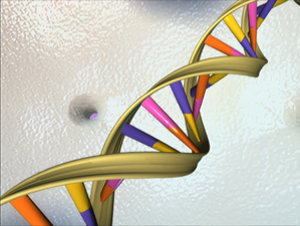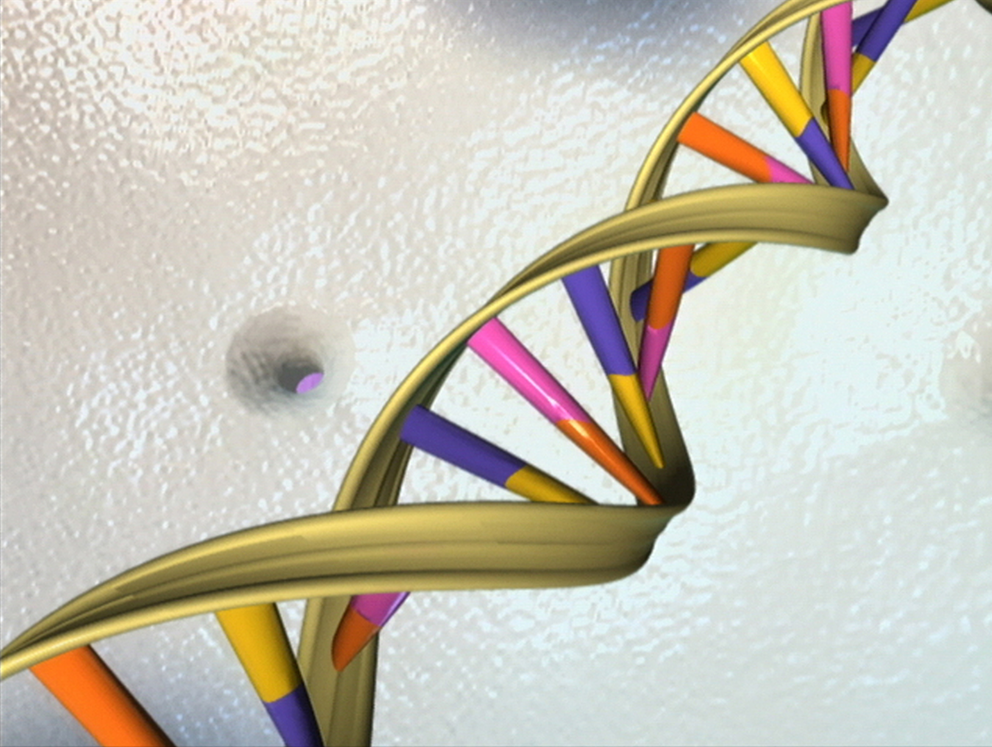Electron Handedness Affects Gas Molecule Breakup
An asymmetric reaction billions of years ago between electrons and the ancestors of biomolecules might explain why today’s DNA always appears as a right-handed helix. Now researchers have shown that a beam of right-handed electrons—whose spin and direction of motion align according to the right hand—breaks apart more right-handed molecules at low energies than left-handed ones. Unlike previous experiments showing such a difference, the reactions occurred in the gas phase and with low-energy electrons, which allowed for a more precise description of the electron-molecule interactions. The researchers say their results are an important step toward more direct tests of the hypothesis that nuclear asymmetries led to asymmetries in present-day biomolecules.
Many molecules come in both left- and right-handed (chiral) forms, but natural DNA is always right-handed. The asymmetry “is one of the few unsolved fundamental questions in [the] natural sciences,” says Uwe Meierhenrich, a physical chemist at the University of Nice Sophia Antipolis in France.
One possible explanation comes from nuclear physics. The radioactive decay of a nucleus is more likely to produce a left-handed electron than a right-handed one—meaning that it’s more likely to spin in the direction of your left hand’s curled fingers when you point your left thumb in the direction of its motion. When this asymmetry was discovered in 1957, “it showed us that God is not ambidextrous,” says Timothy Gay of the University of Nebraska in Lincoln.
Indeed, cosmic rays that constantly pelt the Earth should produce a preponderance of these southpaw electrons, generated by the rays’ interactions with the atmosphere. The Vester-Ulbricht hypothesis, proposed more than 50 years ago, says that these lefty electrons selectively destroyed molecules of one handedness—say, left-handed precursors of DNA—which led to the asymmetry in DNA and other biomolecules we see today.
The selectivity of left-handed electrons among chiral biomolecules is generally too weak to test directly and is assumed to have been amplified somehow. Instead, researchers have been trying to demonstrate merely that polarized (right- or left-handed) electron beams can have detectable effects on at least some chiral molecules. Various experiments have shown such effects but have not revealed the details of the mechanisms. In one recent test, for example, polarized electrons sent through a solid film broke bonds in right-handed film molecules at a different rate than they did for left-handed molecules [1]. But the speedy electrons hitting the solid might have produced bremsstrahlung radiation or interacted with the film in another way that could have broken the bonds, says Gay, so the mechanism remains uncertain.
Now he and Nebraska colleague Joan Dreiling have run a similar experiment using a gas target. They used slow electrons, which have a negligible chance of producing bremsstrahlung radiation, says Gay. “We wanted to have a very clean chemical reaction.”
The researchers shot a beam of right- or left-handed electrons into a cylinder filled with a gas of either right- or left-handed molecules of bromocamphor, an organic molecule that is easy to vaporize. An incoming electron would stick to the molecule, causing it to break in two in a process called dissociative electron attachment, says Dreiling. Then the fragment with the extra electron would fly into the walls of the cylinder and would be detected by a sensitive current meter.
The team measured a tiny difference in the current produced depending on which version of bromocamphor was used, suggesting that right-handed electrons destroy 0.03% more right-handed molecules than their lefty counterparts at the lowest energies the researchers studied. “The effect is very small,” says Gay, “but we are absolutely seeing an asymmetry.”
Just why the polarized electrons preferentially broke apart one handedness of the molecule is still unclear. But showing that they did allows researchers to zero in on the details with more experiments. In any case, Dreiling and Gay say the result bolsters the Vester-Ulbricht hypothesis because it shows an asymmetry in a well-defined chemical reaction, even though they acknowledge it is just a first step before studying biological molecules. “The leap to biology is enormous,” agrees Max Bernstein, an astrochemist at NASA, in Washington, DC.
The effect is small, but Meierhenrich says the asymmetry could have been amplified over time. “Such tiny effects might have [existed] at the very beginning,” he says. “This is a good start,” says Jason Dworkin of NASA’s Goddard Space Flight Center in Greenbelt, Maryland, who looks forward to future studies with the precursors of biomolecules.
This research is published in Physical Review Letters.
–Maggie McKee
Maggie McKee is a freelance science writer in Boston.
References
- R. A. Rosenberg, M. Abu Haija, and P. J. Ryan, “Chiral-Selective Chemistry Induced by Spin-Polarized Secondary Electrons from a Magnetic Substrate,” Phys. Rev. Lett. 101, 178301 (2008)





